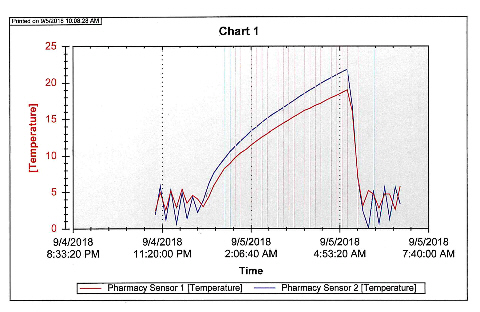One Simple Way to protect Your Cold Storage Inventory During Power Failure
Recently we received a panicked call from one of our customers. She had a power outage the previous night and had not gotten an alarm from her TV2. It turns out that the computer running the TView software that was supposed to send the text alert was not on a battery backup. So no warning was sent or received. The next morning, after restarting her computer, she downloaded the data from the TV2.
See below:

The chart shows a sharp increase in temperature in two refrigerators beginning at 1:16am. The temperature in each unit rose above 8°C at that time and continued to rise to a high of 21.73°C at 5:56am. Apparently the power was restored at that time because the temperature dropped to 6.79°C by 6:06am. The chart also showed the TV2 sending high temperature alarms every few minutes: These are the red and blue vertical lines beginning at 1:16am.
The TV2 monitor was linked to the Local area Network and a computer was running the TView software so if all went according to plan that computer would have sent ever one of these alerts to multiple text and emails.
So someone would have had to get out of bed and come into the pharmacy but thousands of dollars of materials would have been saved. Unfortunately the computer which should have received the alarms and sent email and text alerts was without power so no one was notified.
The chart graphically shows how it is possible for a refrigerator to malfunction or quit working because of a power failure and warm up to the extent that everything in the fridge is compromised and then to cool back down so that all is normal by the time everyone shows up for work the next morning.
This chart can teach us a lot:
- The power was out from 1:16am until 5:56am.
- I can tell by looking at the chart that these two refrigerators are glass door units. Glass is a very poor insulator so when power was interrupted it did not take long for the temperature to rise into the danger zone. Refrigerators with metal doors stuffed with insulation are quite capable of maintaining their temperature during a power outage for several hours. Had they been refrigerators with metal doors it is possible that no inventory would have been lost
- These refrigerators have powerful compressors, because it took less than 20 minutes to pull the temperature from almost room temperature to less than 8°C.
- This chart highlights the danger of using a data logger without an alert system of some sort in place. In this case the user has decided to add an autodialer so she gets a phone call if power fails again.
- All of the alarms were recorded so if the user had installed an inexpensive Uninterrupted power supply to her computer she would have been notified in plenty of time to move the inventory to a safe storage unit.
- Even though regular wall power was interrupted the TV2 continued to perform all functions, including logging, alarming, alerting and charting because it was equipped with a battery backup. The internal battery is capable of running the TV2 for more than 72 hours.
The final lesson from this experience is that it is foolish to not put a battery backup on a computer which is responsible for sounding the alarm if the power fails.
UPS units are very inexpensive (usually, less than $99) and worth their weight in gold during a power outage. It buys time, and most importantly, peace of mind.



